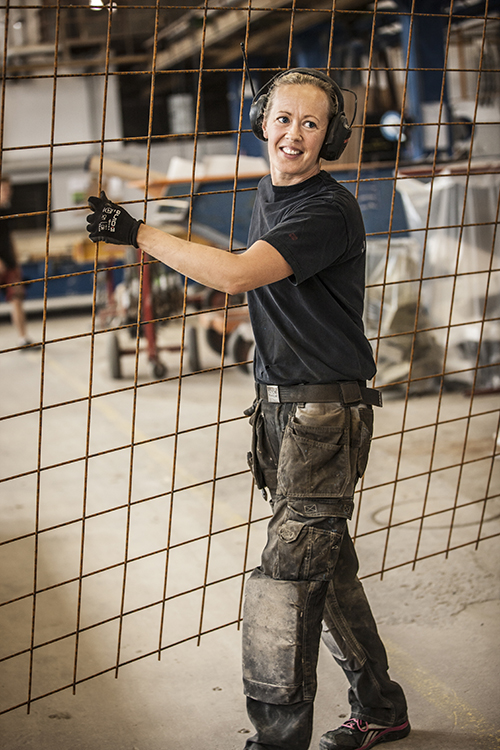
CARE
To maximise the life of a protective garment it is important to look after it correctly, as this makes good financial sense and also contributes to sustainability – after all, the most environmentally friendly product is the one that never has to be produced. The lifetime of a garment is affected by every stage in its life, from buying through to the disposal of the workwear.
BUY
The first and most important step when it comes to investing in the safety of your personnel is to ensure they can work safely by carrying out a risk analysis. Tranemo does not take a multinorm approach, but instead develops each protective garment using materials and features that are designed to meet specific working conditions or risks - thereby giving the user the best possible protection. Our extensive experience in product development, especially with flame retardant materials, means that we can guide you to the right collections and garments. Once the risks have been identified, the next step is to find garments that are comfortable and fit well, so that everyone will be happy to use them every day. This is why we offer garments in a wide range of sizes, so that everyone can find a size that fits, which is vital to achieve full protection. We stock most of our trousers in 34 different sizes.
USE
Every certified protective garment is supplied with user instructions that describe standards and requirements, and give tips on how to wear and look after the garment. Before a garment is used it is important to read through these instructions to learn what protection the garment provides and how it should be used. Each safety garment has a label inside that gives details of the certifications it meets, but to achieve full protection it will often be necessary to wear additional personal protective equipment (PPE) such as gloves and shoes.
WASH
It is essential that all Flame Retardant garments are washed in a professional manner in accordance with specific washing instructions to ensure that the features and benefits are not compromised or lost. Only synthetic detergents should be used. Do not use soap detergent or softeners and garments should not be bleached.
Tranemo recommends:
» Protective clothing certified according to EN ISO 20471 must be washed separately or alternatively together with other garments certified according to EN ISO 20471.
» For garments that contain wool, proper care is very important. Wool is sensitive to high pH levels and should therefore be washed in a neutral pH gentle wash process. Protective clothing containing wool should also be washed on a special wool program.
» In order to meet the requirements of EN 13034, the protective clothing needs to be re-impregnated in order to maintain the chemical protection. Tranemo recommends re-impregnation using an industrial laundry that is capable of carrying out this process.
Contact Tranemo for full information on washing procedures and detailed care instructions.
Washing symbols
| Wash at max 40°C | Tumble dry low temprature | ||
| Wash at max 40°C, gentle wash | Do not iron | ||
| Wash at max 60°C | Ironing max 110°C | ||
| Wash at max 60°C, gentle wash | Ironing max 150°C | ||
| Do not tumble dry | Do not dry clean |
REFLECTIVE TAPE TRANSFERS
Stitched on reflective stripes can feel hard, stiff and give an uncomfortable feel to knitwear that is often soft and elastic. The use of segmented heat sealed reflective stripes makes the garments more compliant compared to ordinary stitch-on reflective stripes. Even on some lighter garments in woven fabrics, heat sealed reflective stripes have a strong advantage in terms of comfort. To maintain reflection, the heat sealed reflective stripes should be washed at a neutral pH (i.e. do not use detergents with pH above 8).
Tranemo recommends:
» Washing at maximum 60°C
» Avoid alkaline detergents, pH<8 is recommended.
» Do not use softener, bleaching agents or optical whiteners.
» Hang drying or tumble dry at max 60°C. For tunnel drying, maximum 100°C is recommended
MAINTENANCE AND REPAIRS
After washing, the garment should be inspected by a safety engineer or other qualified person. Do not use damaged Protective Clothing that cannot be repaired (i.e. holes or tears in the garment, closure not functioning properly). Small damage that does not affect the garments overall protection can be repaired, prolonging the lifetime of a garment by repairing it will also reduce our environmental impact. Repairs should not impair the performance of the Protective Clothing; and any repairs should only be done in accordance with Tranemo repair instructions and using identical fabrics and components. If needed, Tranemo can provide a repair kit as an optional product and provide guideline repair instructions.
REPLACEMENT – DISPOSAL
When a garment has been in direct contact with flame or strong heat, it may be brittle and weakened and should therefore be disposed of. If the garment has been exposed to chemicals which have penetrated the fabric, this will normally mean a degradation of the protection and it should be taken into consideration whether the garment should be discarded and replaced.
MORE INFORMATION

